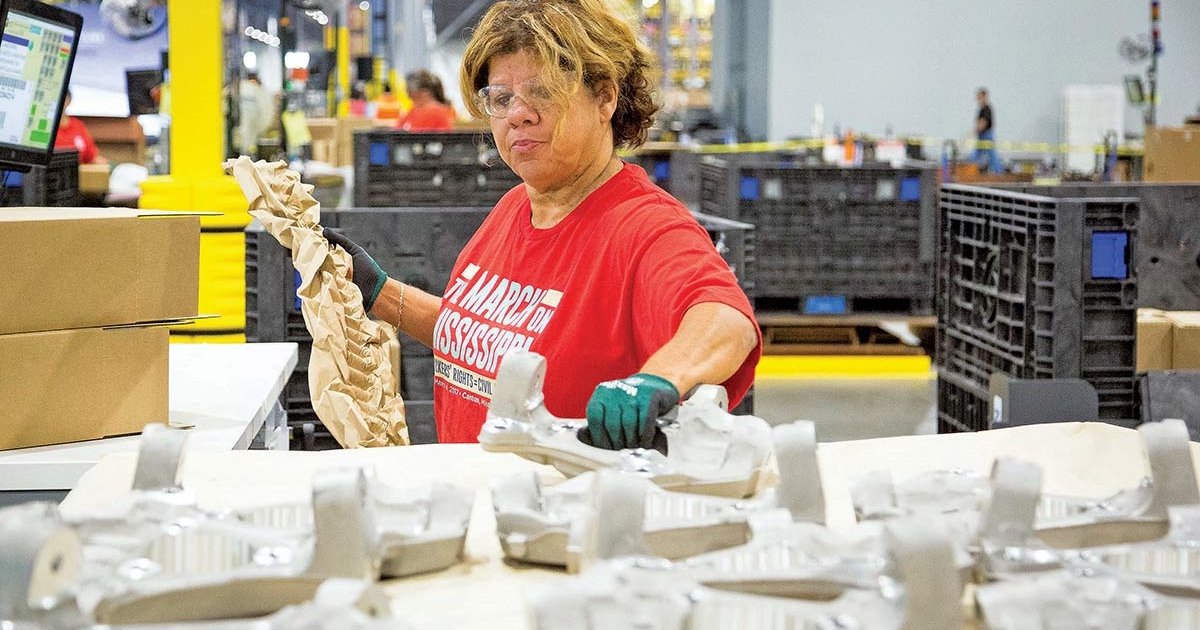
BURTON, Mich. — General Motors’ largest parts processing center is fulfilling the needs of car buyers of the 2010s while preparing its operations for the automaker’s all-electric future.
“This plant is what I like to call ambidextrous. It’s got the right hand moving at the same time the left hand is moving,” said John Roth, GM’s vice president of global customer care and aftersales. “You have this running the day-to-day element that needs to happen while you’re planning for this future of EVs and additional models that are going to join the GM lineup. You’re always looking ahead and trying to adapt and learn.”
GM’s Customer Care and Aftersales division is responsible for processing parts for vehicles two years before launch to vehicles that were on the market 10 years ago. Today, that scope ranges from all internal combustion vehicles, plus alternative powertrain models such as the Chevrolet Volt and Cadillac ELR from the 2010s, to the electric pickups, crossovers and SUVs that GM will launch over the next two years. By 2035, the automaker aims to launch an all-electric light-vehicle portfolio in North America.
The Davison Road Processing Center here, about 8 miles from GM’s heavy- duty pickup plant and about 75 miles from its headquarters in Detroit, opened in 2019 when GM consolidated another parts plant in Burton with a plant that was located in West Chester, Ohio.
The 1.1 million-square-foot facility runs on two shifts of nearly 1,500 workers and ships 576,000 parts each day. The plant works with $44 million worth of inventory — such as door handles, mufflers and steering wheels — and ships to 218 customers in 95 countries.
“EVs are actually additive to the day-to-day internal combustion engine vehicles that we support today,” Roth said. “Here’s our opportunity to be agile. [How do EVs] become complementary to what we’re already doing as part of the core business today? That’s the mindset.”
GM’s three processing centers ship parts to 88 warehouses around the world. Over each of the past two years, the Customer Care and Aftersales division has grown its business by double digits.
“We’re on another glide path to see double-digit growth again this year. Consumers are driving again; miles driven are up,” Roth said. “We’re able to fill orders that others can’t. And so we’re seeing more and more consumers coming our way because we have the product they need, and we can give them the experience they look forward to.”
Roth became GM’s vice president of customer care and aftersales in 2020, replacing GM veteran Tim Turvey. Roth had been president and managing director of the automaker’s Africa and Middle East operations, and previously he held leadership posts in Canada, sales and aftersales during his three decades at GM.
In spring 2020, many dealers had to halt sales or adjust strategies as the coronavirus spread. But repair demand soon grew. GM established command centers to establish which parts were needed where and when.
Customer Care and Aftersales also has a sales and marketing team for GM Genuine Parts and ACDelco parts, and it helps train dealers in the field on technical skills and customer service.
“A lot of people look at aftersales, and they think it’s just parts,” said Roth. “There is so much more to it than that. This is every bit as complex as running a region.”
In January, GM Customer Care and Aftersales launched a technician excellence program to recognize dealership technicians who complete virtual and hands-on training.
About 70 percent of GM dealership technicians enrolled in the first quarter.
Its customers range from dealerships and consumers to aftermarket providers and GM subsidiaries.
“We have to think about the whole customer experience, everything from do-it-yourself to do-it-for-me and everything in between,” Roth said. “And we have to write those manuals. We have to build out those schematics. We have to do the marketing and brand-building that we do. We have to ensure that it’s a quality part and that there isn’t counterfeit.”
Last year, the Davison Road Processing Center began replenishing batteries for the Chevy Bolt EV and EUV after battery-fire risk prompted a recall of all Bolts. The plant has handled 7,500 battery replacements for markets in Europe and Asia.
Replacing the Bolt batteries taught workers at Davison about international battery-handling, storage and safe transport.
“It’s new technology, and we want to be ahead of the curve from a process standpoint to ensure that everything is done safely and done efficiently,” Roth said.
“They’re able to manage the day-to-day and do that test-and-learn idea on the side as well. That’s that ambidextrous capability that exists here.”